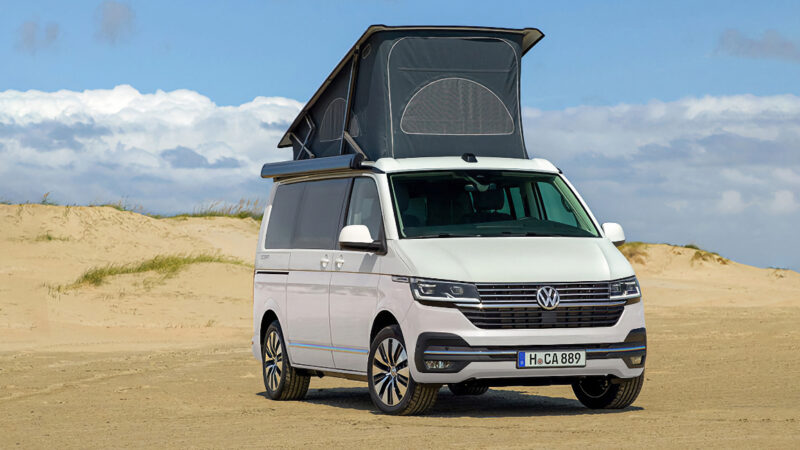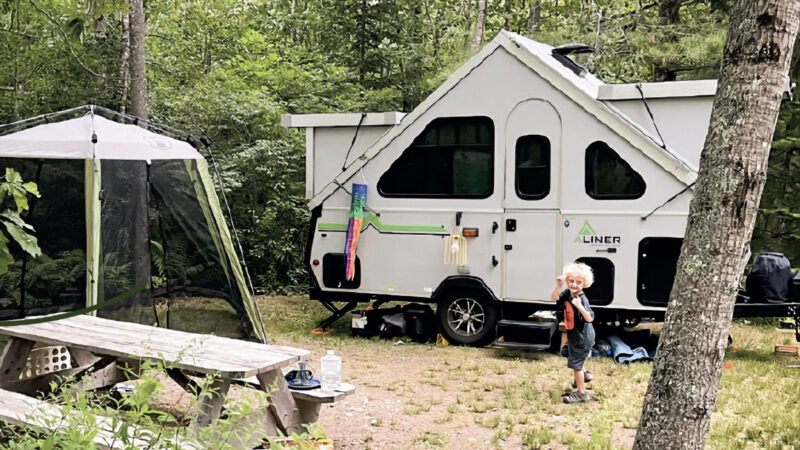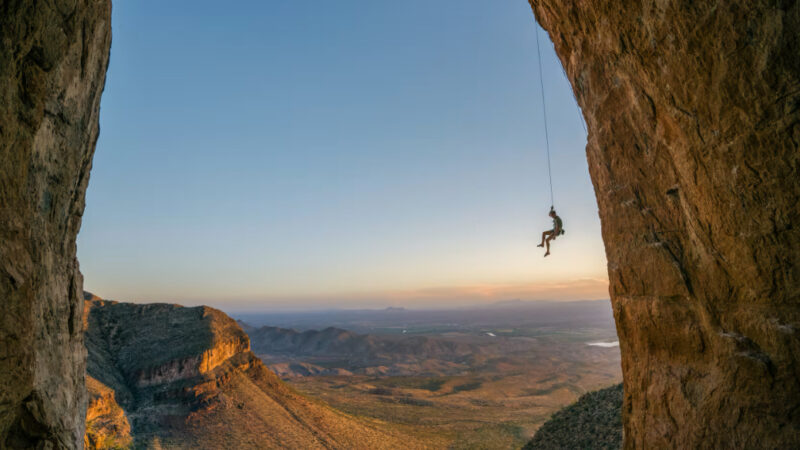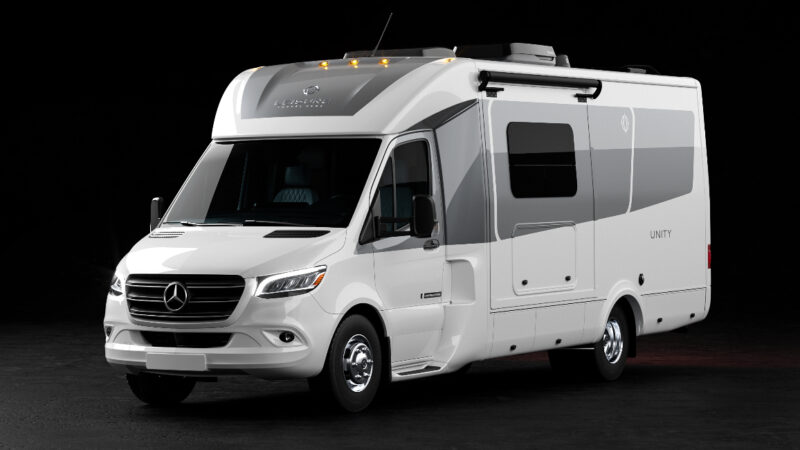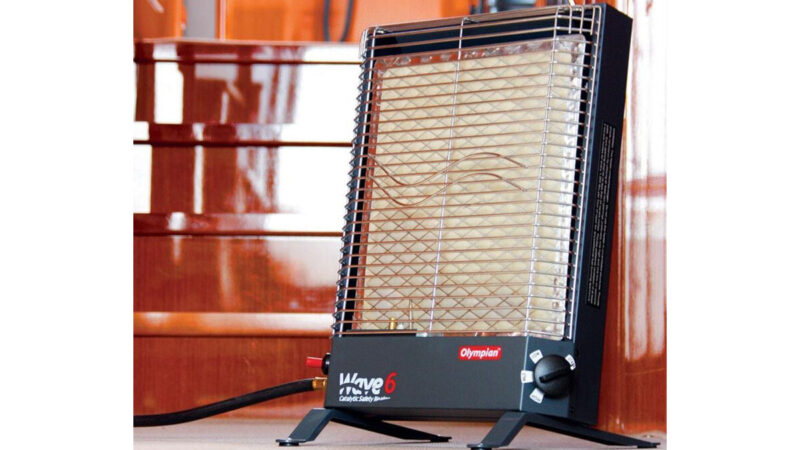6 Ways to Create an RV Office Space
There once was a time when being able to work from anywhere seemed like a pipe dream reserved for the digital nomads and those deeply immersed in the gig economy. But over the past few years, that has changed dramatically, with more and more of us now given the freedom to do our jobs from virtually anywhere. As a result, an increasing number of RVers have embraced life on the road, holding down a fulfilling job while traveling full or part-time.
While some RV manufacturers have embraced this shift in culture by adding workspaces to their vehicles, most motorhomes and travel trailers aren’t equipped for remote work. But with a bit of creativity and focus, it is possible to create a productive work environment inside your rig. These are our tips to help you do just that.

Image Courtesy of welcomia/Getty
Find and Define Your Workspace
One of the first steps to creating an RV office is to find a space that allows you to work efficiently and productively. For some, that might mean converting the dinette into a desk during work hours, allowing you to set up a laptop or tablet, spread out documents, take notes, and so on. Others might be more comfortable working on a couch or chair using a lap desk. Some RVs even have foldout tables or large flat surfaces near the driver and passenger seats that make perfect workstations, as well. Which one works best for you depends on how you prefer to work and where you can get comfortable.
Most motorhomes and travel trailers don’t come with a desk, but if you own a larger RV, you may have the space to add one. Some Class A or fifth-wheel owners convert a spare bedroom into a dedicated office. Toy haulers often have extra room for a mobile office, too. But if you drive a Class B model or a truck camper, you probably won’t have that kind of space. Instead, you’ll have to find an area where you can be comfortable and productive. That could include working outside when the weather conditions are right.
The goal is to create a place in or around your RV that is free from distractions and allows you to focus. It doesn’t have to be a spot where you’ll sit still for eight hours a day, but it should provide the space and comfort you need to consistently get things done. Once you’ve defined your “office,” it becomes easier to get into work mode and accomplish what you need to do to continue to pursue your career.
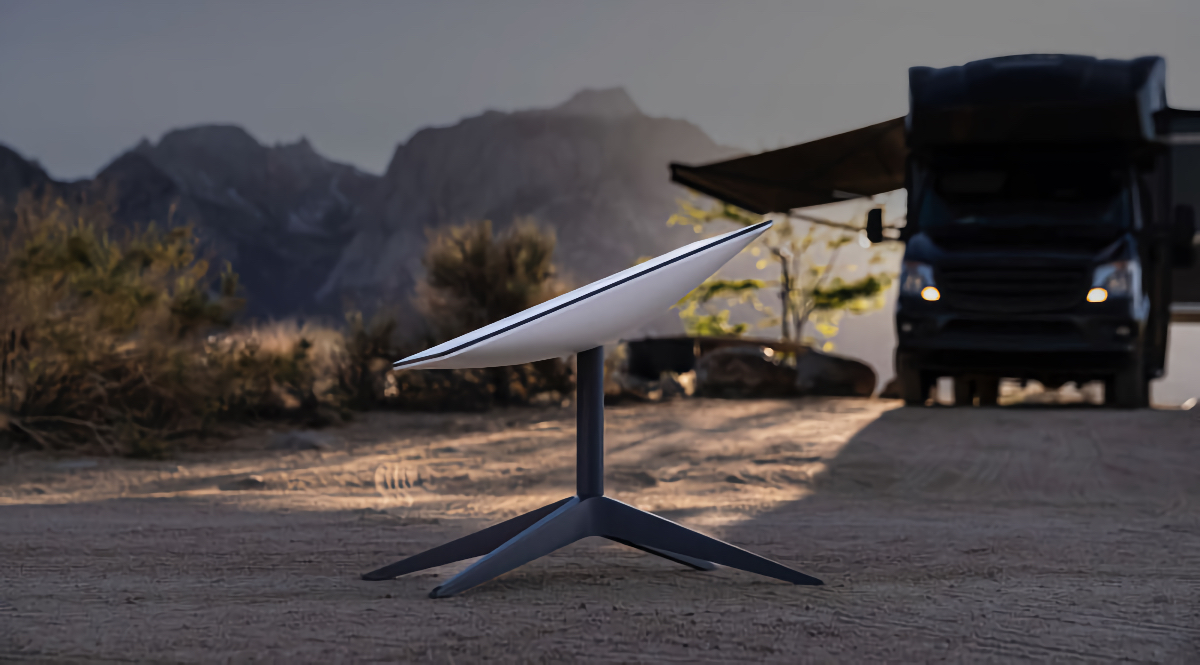
Image Courtesy of Starlink
Reliable Internet is a Necessity
Powerful notebook computers and better productivity tools have made remote work possible, but a reliable internet connection is still crucial to staying productive. After all, you can’t attend a Zoom meeting or upload documents if you can’t stay connected while on the road. Thankfully, there are several ways to maintain a fast connection that doesn’t involve relying on the notoriously slow free Wi-Fi found at most campgrounds.
One of the easiest ways to maintain a connection is by installing a Wi-Fi/cell range extender—such as the Winegard Connect 2.0—on your RV. These devices connect to nearby wireless networks, boosting signal strength, reliability, and speed. This can take an otherwise-shaky connection and make it much more useful.
Another option is to tether your computer to your smartphone. This allows your laptop to piggyback on your phone’s 5G connection, often producing download speeds rivaling home internet service. Most providers enable tethering as part of your cellular plan and offer unlimited data, although speeds may be throttled due to excessive date use. Alternatively, you could invest in a wireless hotspot, which costs a little more but usually offers better performance, particularly for more than one user.
Starlink satellite internet is another option for obtaining a fast connection, even when traveling in remote places. The service’s monthly fees can be expensive, but it is a reliable way to stay connected while on the go. So much so that a number of RV manufacturers now offer the option to have a Starlink antenna installed at the factory, allowing it to provide a wireless connection even while driving. This can be a real game changer for the work-from-anywhere crowd.
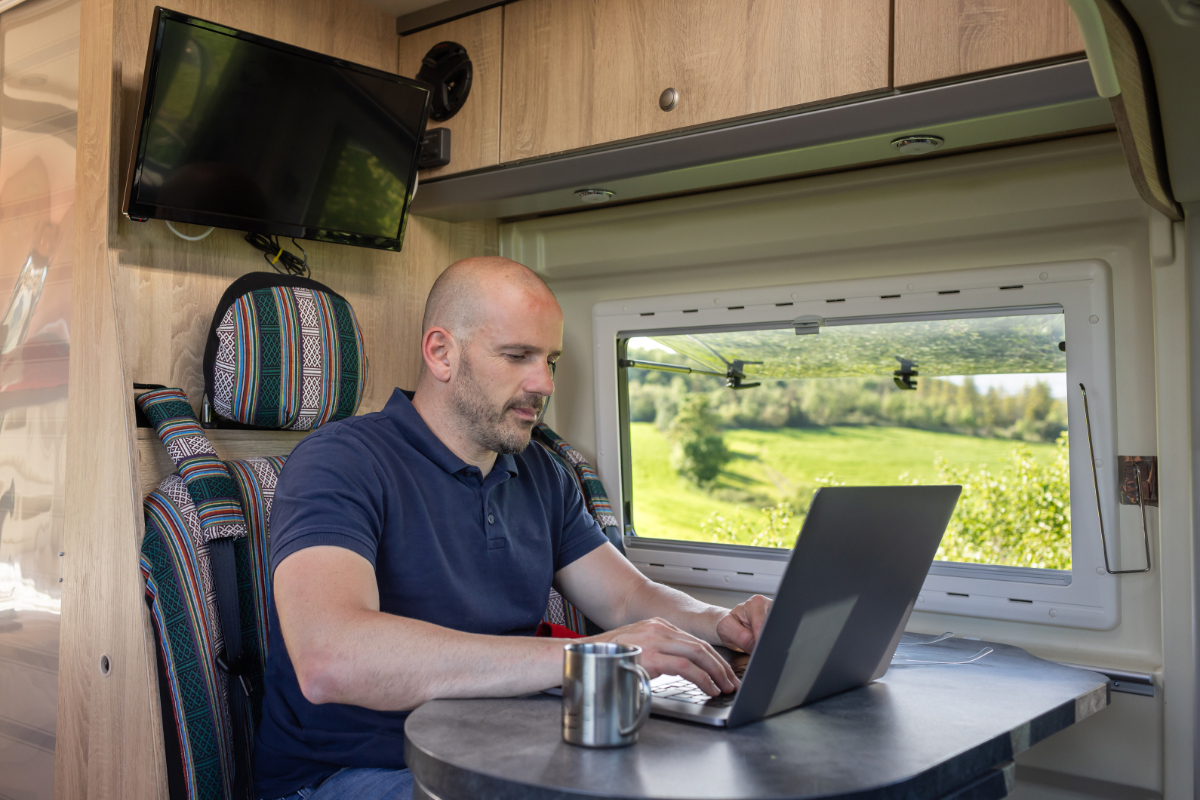
Photo Credit: Mikel Allica/Getty
Add an External Monitor
A good laptop is essential for working remotely, but a small screen can sometimes make it a challenge to do our jobs. Fortunately, it is easy to add an external display for some much-needed additional screen real estate. One of the easiest ways to do that is to connect your computer to a TV using a standard HDMI cable. If there isn’t a television in your workspace, you could also mount a computer monitor to the wall instead.
But you don’t have to break out the drill and mounting bracket to get the benefits of a larger display. Many remote workers simply travel with an external monitor, setting it up when needed and carefully packing it away when not in use. If storage space is a concern, you can always use a smaller portable USB monitor instead. Depending on your computer ecosystem, you may even be able to use a tablet as a secondary display.

Photo Credit: simonapilolla/Getty
Accessorize Your Workspace
In addition to adding a monitor, there are a few other accessories that may help make you more productive while working on the road. For instance, a wireless keyboard and mouse are excellent additions to any office space, with the added benefit of easily tucking away at the end of the day. They’re also highly portable, allowing you to move to other areas of the RV or even outside when you need a change of scenery.
Other accessories to consider include a laptop stand to elevate the computer’s screen and webcam and a dock for managing cables and providing easily accessible USB ports. An external microphone and webcam may upgrade the experience if you’re recording audio or video. If you need to illuminate your work area, add a lamp or brighter LED bulbs to existing fixtures. If you have the room, a proper desk chair can make life easier, too.
Beyond these suggestions, feel free to make your mobile office your own. Add the things you need not just for getting your job done but for personalizing your workspace. Add photos, gadgets, desk accessories, or whatever else you need to be productive. Let your imagination and creativity run wild.
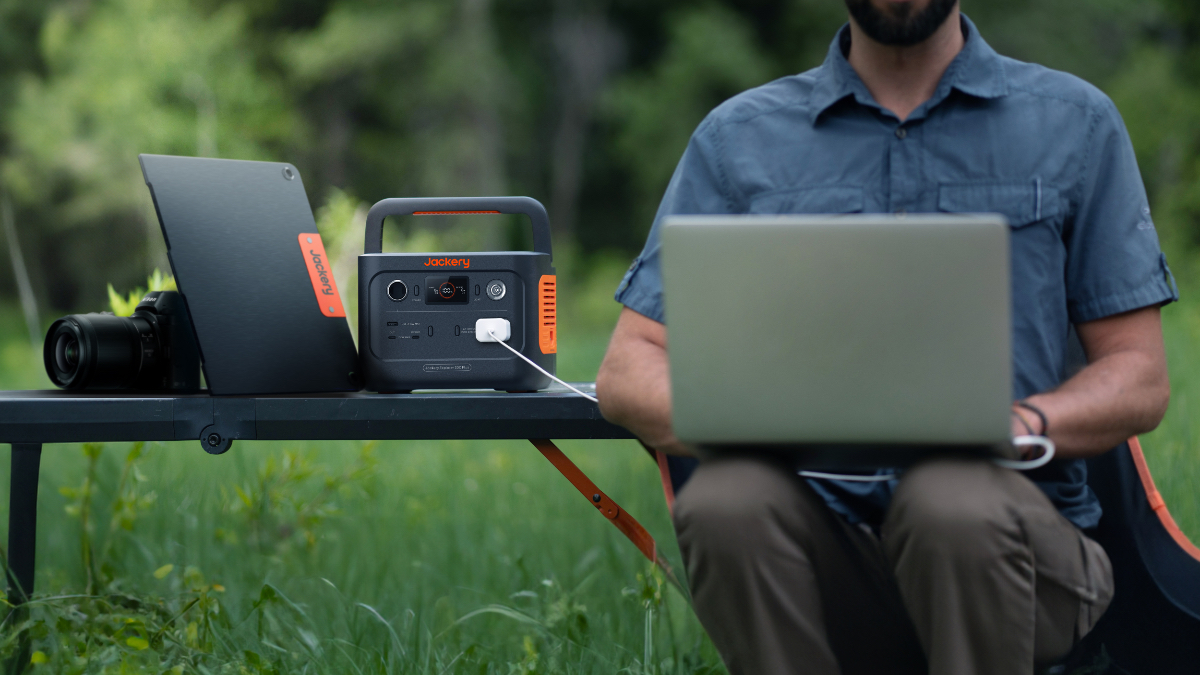
Photo Credit: Jackery
Amp Up the Power
Another important thing to consider is whether or not your RV can provide enough power for working remotely. This isn’t much of an issue when parked at a campsite with full hookups, but it may be a concern if you’re camping off-grid. Using a laptop, monitor, Wi-Fi, and other devices doesn’t draw a tremendous amount of power, but it does add up over the hours. That could cause your house batteries to drain faster than you would expect and leave you scrambling for electricity when you need it most.
If your motorhome or travel trailer doesn’t have solar panels and lithium batteries, it is probably time to install them or upgrade to a newer model. Adding solar and more efficient power cells will give your rig greater energy independence and make working on the road much easier. A high-quality inverter will also ensure your devices receive clean electricity at all times, proving extra protection for delicate circuitry.
Alternatively, you could also invest in a portable power station. These devices come in various sizes and are a quick and easy way to add additional power to any RV. Most can recharge using solar panels, and they can easily be moved around the campsite for use wherever you end up working.

Photo Credit: doble-d/Getty
Get Some Peace and Quiet
Busy campgrounds can be noisy sometimes, which isn’t always conducive to getting work done. For some of us, those noises aren’t all that distracting, but for others, they can completely take us out of our workflow. Requesting a campsite that is located away from the busier sections of the campground can help in this regard, keeping traffic and noise to a minimum. Working during designated quiet hours can also be helpful, although usually those times extend from late evening into the early morning hours.
Noise-canceling earbuds and headphones can also help create a less distracting work environment. In fact, many office workers use them in cubicles to reduce background noise. These devices filter out unwanted sounds while allowing you to listen to music, podcasts, audiobooks, or just white noise. Most come with built-in microphones, making them useful for conference calls, too. Modern headphones are so good, in fact, that you’ll probably find yourself using them beyond your usual work hours.
Hopefully, these tips will help you create the creative and flexible workspace you need to support your work-from-anywhere lifestyle. Whether that means living on the road full-time or just taking advantage of the freedom that comes with a remote job, it is essential to have a proper place where you can get things done. Once you’ve had a chance to adjust to your mobile office, you’ll wonder why you hadn’t embraced this lifestyle sooner.
The post 6 Ways to Create an RV Office Space appeared first on RV.com.
Source: https://www.rv.com/lifestyle-travel/6-ways-to-create-an-rv-office-space/


